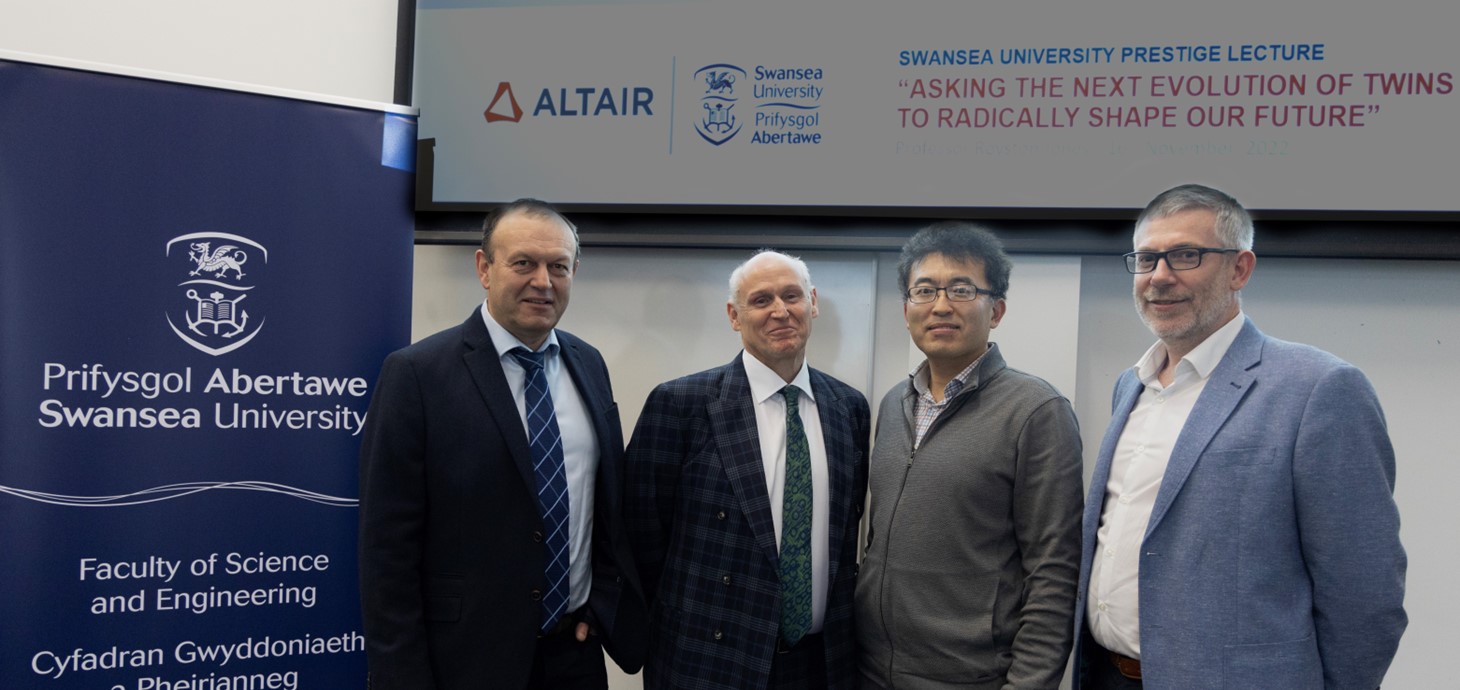
(L-R) Professor Hans Sienz, Professor Royston Jones (Altair), Professor Chenfeng Li and Jamie Buchanan (Altair) at the prestige lecture.
A Swansea University prestige lecture entitled “Asking the Next Evolution of Twins to Radically Shape Our Future” has been delivered by Professor Royston Jones, the Executive Vice President of European Operations and Global CTO of Altair, a global leader in simulation, AI and high-performance computing, at an event at the Faculty of Science and Engineering.
The lecture, which explored advances in the application of digital twin technology coincided with the formation of the university’s new Zienkiewicz Institute for Modelling, Data and AI.
The Institute is named after the late Professor of Civil Engineering Olek C. Zienkiewicz, who pioneered the finite element method and had a broad vision of modelling the world and using computers to generate and explore data to solve engineering problems.
Professor Jones was a student of Professor Zienkiewicz between 1978 and 1984 and has said that the experience shaped his future in industry as a pioneer of the industrial application of the finite element method to produce design innovation.
Over the years Professor Jones has maintained close links with Swansea University through collaborative research, as advisor on strategic initiatives, and by delivering lectures, supporting student development, providing training for research students, and informing the development of the faculty through his membership of industrial liaison committee for aerospace engineering. Through his extensive industrial and academic network, he also brought world leading automotive companies to Swansea resulting in new collaborations.
It is in this research collaborator and ambassadorial role, mainly in the area of finite element analysis, simulation driven design and its industrial applications, but also in the wider area of design and design for manufacturing, where Professor Jones has and will continue to make significant contributions to the faculty, enhancing Swansea University’s reputation across the world via industrial links.
Professor Jones said:
“Professor Zienkiewicz and the entire Department of Civil Engineering were an inspiration to me. It was an incredibly exciting time being part of this global centre of excellence for numerical methods at the heart of the methods research. I was propelled into industry by the University’s strong vision that finite elements would become the leading engineering tool. It has been a great source of pleasure over the last four decades to see this vision becoming a reality. Even today, I’m still tremendously excited by where the technology will take us, since I believe we are still a long way from realising its full potential. At Altair, we see a convergence between simulation (modelling), data analytics (AI) and high-performance computing. Consequently, the establishment of the Zienkiewicz Institute makes perfect sense and is well aligned to current technology trends and the requirements of industry. It was a great honour to deliver this lecture to the Faculty of Science and Engineering.”
The new Zienkiewicz Institute for Modelling, Data and AI, which has been created to replace the Zienkiewicz Centre for Computational Engineering, will see Computational Engineering evolving into a broad Modelling, Data Science and AI research institute
The institute encompasses a large number of full‒time, part–time and emeritus academic staff members, post-doctorate students, independent researchers, and graduate students and aims to provide a recognisable Swansea community for various internationally renowned researchers and research groups.
Interim Pro-Vice Chancellor and Executive Dean of the Faculty of Science and Engineering, Professor Hans Sienz said:
“As we are about to embark upon a revolution of disruptive markets, products and services, it is the combination and connectivity of mature and of emerging technologies that will dramatically impact our futures. The convergence of data science with Swansea’s traditional strengths in computational engineering will be transformational for the reach and the impact of our research delivered through close collaboration such as the one with Altair.”
View the lecture “Asking the Next Evolution of Twins to Radically Shape Our Future.”
